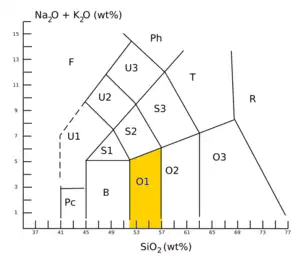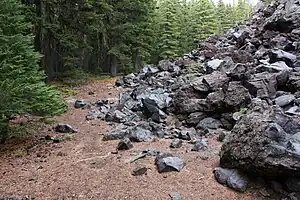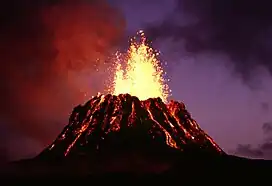
Basaltic andesite is a volcanic rock that is intermediate in composition between basalt and andesite. It is composed predominantly of augite and plagioclase. Basaltic andesite can be found in volcanoes around the world, including in Central America[1] and the Andes of South America.[2]
Description

Basaltic andesite is a fine-grained (aphanitic) igneous rock that is moderately low in silica and low in alkali metal oxides. It is not separately defined in the QAPF classification, which is based on the relative percentages of quartz, alkali feldspar, plagioclase feldspar, and feldspathoids, but would fall in the basalt-andesite field.[3] This corresponds to rock in which feldspathoid makes up less than 10% and quartz less than 20% of the total QAPF fraction, and in which at least 65% of the feldspar is plagioclase.[4] Basaltic andesite would be further distinguished from basalt and andesite by a silica content between 52% and 57%.[5]
Although classification by mineral content is preferred by the IUGS, this is impractical for glassy or very fine-grained volcanic rock, and then the chemical TAS classification is used. Basaltic andesite is then defined as volcanic rock with a silica content from 52% to 57% and a total alkali content (K2O plus Na2O) of less than about 6%, corresponding to the O1 field in the TAS diagram.[4]
A basaltic andesite (or andesite) enriched in magnesium and depleted in titanium, with more than 8% MgO and less than 0.5% TiO2, is termed a boninite.[6]
Occurrence

Basaltic andesite is found in volcanic arcs, such as those of Central America,[1] the Andes of South America,[2] and the Cascades of North America.[7]
Basaltic andesite is also common where the Earth's crust is undergoing extension. For example, mid-Cenozoic volcanic sequences in western Mexico, southwestern New Mexico, and southeastern Arizona are capped by basaltic andesite of the Southern Cordilleran Basaltic Andesite (SCORBA) suite, which may be the most extensive Cenozoic mafic suite in North America.[8] Mount Mazama, a large composite volcano in south-central Oregon, consists of several overlapping basaltic andesite shields.
Basaltic andesite is a component of back-arc basin basalt suites.[9] The Columbia River Basalt Group is composed of 80% basaltic andesites on the basis of silicon content.
Thick sequences of basaltic andesites were erupted in a shallow-marine environment during the Paleoproterozoic as melts formed in the anomalous Kaapval craton lithosphere.[10]
The Mars Global Surveyor has found evidence for basaltic andesite on Mars.[11]
References
- 1 2 Jordan, B.R.; Sigurdsson, H.; Carey, S.; Lundin, S.; Rogers, R.D.; Singer, B.; Barquero-Molina, M. (2007). "Petrogenesis of Central American Tertiary ignimbrites and associated Caribbean Sea tephra". In Mann, Paul (ed.). Geologic and tectonic development of the Caribbean plate boundary in northern Central America. Geological Society of America. p. 161.
- 1 2 Kay, Suzanne Mahlburg; Copeland, Peter (2006). "Early to middle Miocene backarc magmas of the Neuquén Basin: Geochemical consequences of slab shallowing and the westward drift of South America". In Kay, Suzanne Mahlburg; Ramos, Victor A. (eds.). Evolution of an Andean margin: a tectonic and magmatic view from the Andes to the Neuquén Basin (35 degrees-39 degrees S lat). Geological Society of America. p. 209.
- ↑ Nesse, William D. (2000). Introduction to mineralogy. New York: Oxford University Press. p. 187. ISBN 9780195106916.
- 1 2 Philpotts, Anthony R.; Ague, Jay J. (2009). Principles of igneous and metamorphic petrology (2nd ed.). Cambridge, UK: Cambridge University Press. pp. 139–143. ISBN 9780521880060.
- ↑ McBirney, Alexander R. (1984). Igneous petrology. San Francisco, Calif.: Freeman, Cooper. p. 498. ISBN 0877353239.
- ↑ Winters, John D. (2014). Principles of Igneous and Metamorphic Petrology. Essex, UK: Pearson. p. 30. ISBN 978-1292021539.
- ↑ Sisson, T.W.; Layne, G.D. (June 1993). "H2O in basalt and basaltic andesite glass inclusions from four subduction-related volcanoes". Earth and Planetary Science Letters. 117 (3–4): 619–635. Bibcode:1993E&PSL.117..619S. doi:10.1016/0012-821X(93)90107-K.
- ↑ Cameron, K. L.; Nimz, G. J.; Kuentz, D.; Niemeyer, S.; Gunn, S. (1989). "Southern Cordilleran basaltic andesite suite, southern Chihuahua, Mexico: A link between Tertiary continental arc and flood basalt magmatism in North America". Journal of Geophysical Research. 94 (B6): 7817. Bibcode:1989JGR....94.7817C. doi:10.1029/JB094iB06p07817.
- ↑ Gaetani, Glenn A.; Grove, Timothy L.; Bryan, Wilfred B. (1994). "Experimental phase relations of basaltic andesite from hole 839B under hydrous and anhydrous conditions". Proceedings of the Ocean Drilling Program, Scientific Results. 135.
- ↑ Cornell, D.H.; Schütte, S.S.; Eglington, B.L. (July 1996). "The Ongeluk basaltic andesite formation in Griqualand West, South Africa: submarine alteration in a 2222 Ma proterozoic sea". Precambrian Research. 79 (1–2): 101–123. Bibcode:1996PreR...79..101C. doi:10.1016/0301-9268(95)00090-9.
- ↑ Ruff, S. W.; Christensen, P. R. (23 May 2007). "Basaltic andesite, altered basalt, and a TES-based search for smectite clay minerals on Mars". Geophysical Research Letters. 34 (10): L10204. Bibcode:2007GeoRL..3410204R. doi:10.1029/2007GL029602. S2CID 10265805.
